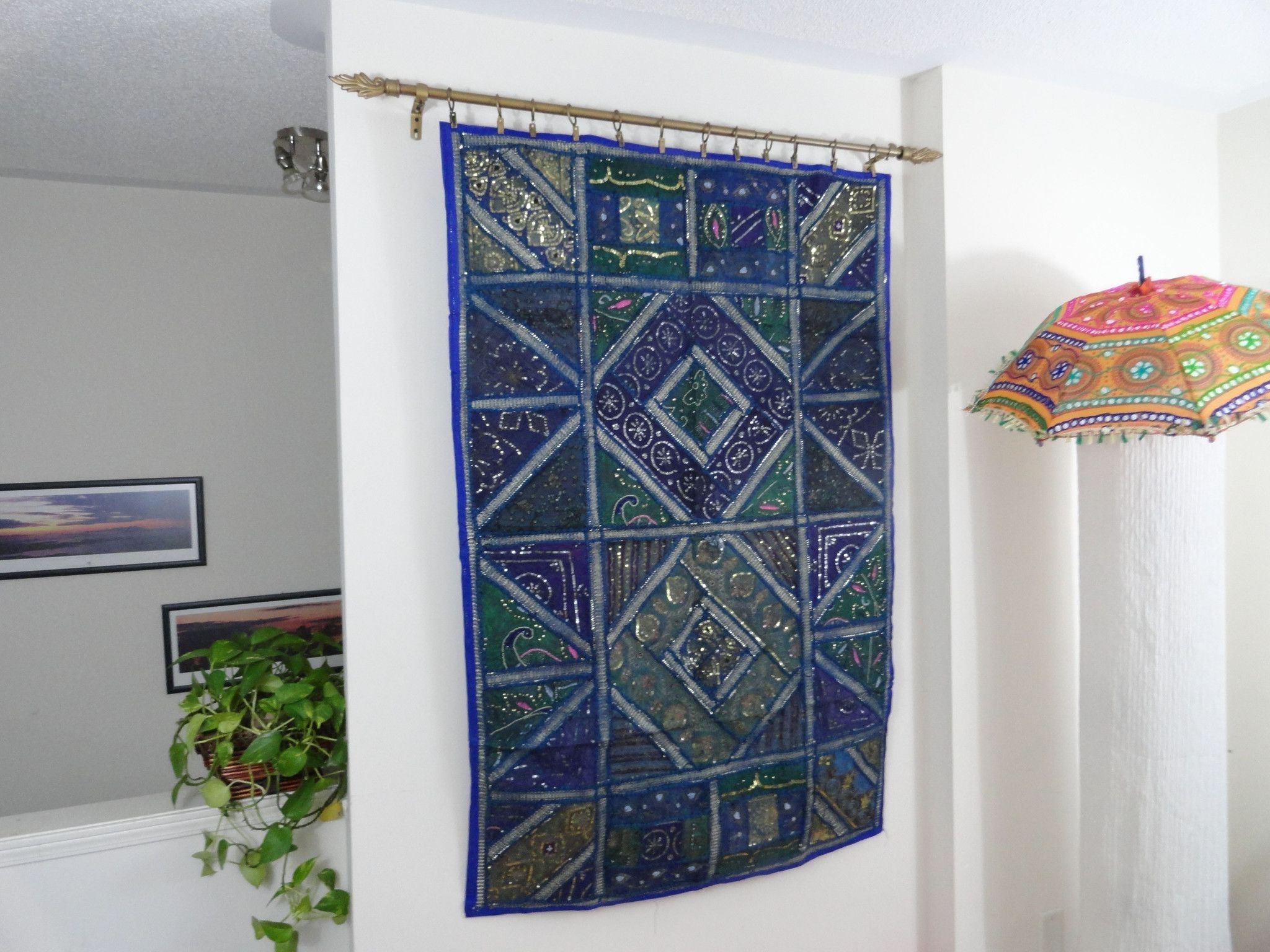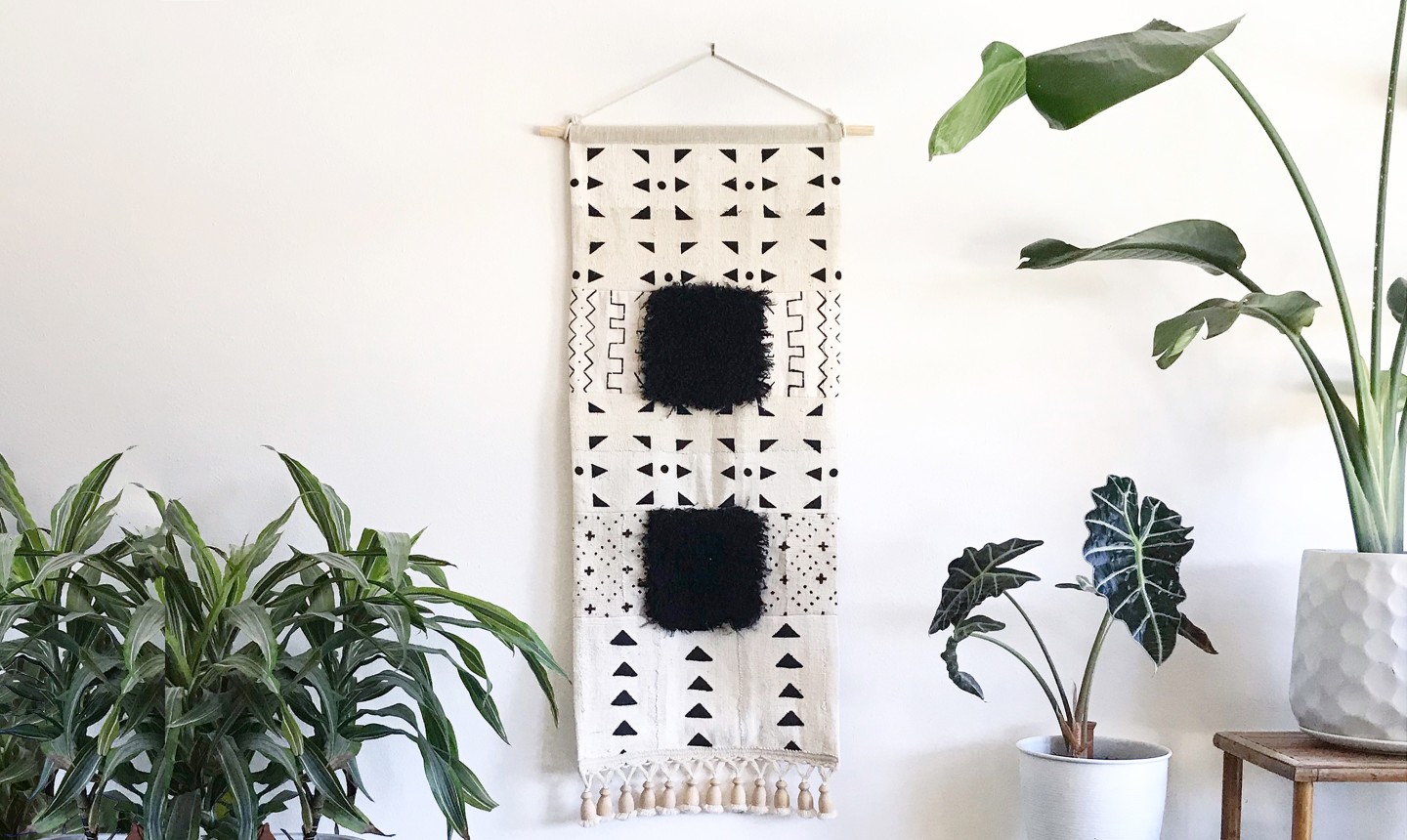Design Elements

Fabric wall hangings offer a versatile canvas for creative expression through a myriad of design elements. These elements, when combined harmoniously, create visually captivating and meaningful pieces that enhance the ambiance of any space.
Patterns, colors, textures, and shapes serve as the building blocks of fabric wall hangings. Patterns can range from geometric precision to organic fluidity, adding visual interest and movement. Colors evoke emotions and set the mood, while textures introduce tactile dimensions that engage the senses. Shapes define the contours and silhouettes of the wall hanging, creating a sense of form and balance.
Patterns
Patterns play a crucial role in creating visual interest and movement in fabric wall hangings. Geometric patterns, with their clean lines and angles, exude a sense of order and precision. Organic patterns, inspired by nature, bring a touch of whimsy and fluidity to the design. Repeating patterns create a sense of rhythm and flow, while asymmetrical patterns add a touch of unpredictability and dynamism.
Bring the serene beauty of the coast indoors with a fabric wall hanging. Its intricate patterns and flowing fabrics add a touch of coastal charm to any space. Whether you opt for a macrame piece or a woven tapestry, these wall hangings effortlessly blend with the modern coastal decor aesthetic, creating a cozy and inviting atmosphere that evokes the tranquility of the seaside.
- Stripes: Vertical or horizontal lines that create a sense of movement and elongation.
- Checks: Intersecting lines that form squares or rectangles, adding a touch of classic elegance.
- Paisley: Teardrop-shaped motifs that evoke a sense of exoticism and luxury.
- Floral: Patterns inspired by flowers and leaves, bringing a touch of nature indoors.
- Abstract: Patterns that lack recognizable forms, creating a sense of mystery and intrigue.
Colors
Colors have a profound impact on the overall aesthetic and mood of a fabric wall hanging. Warm colors, such as red, orange, and yellow, evoke feelings of energy, passion, and warmth. Cool colors, such as blue, green, and purple, create a sense of tranquility, serenity, and coolness. Neutral colors, such as white, black, and gray, provide a versatile backdrop for other colors and patterns.
Fabric wall hangings add a touch of rustic charm to any farmhouse decor, their intricate patterns and textures creating a cozy and inviting atmosphere. For a more modern twist, consider a farmhouse wall clock , its distressed finish and bold numerals adding a touch of industrial chic.
Whether you prefer the warmth of fabric or the sleekness of metal, these decorative accents will elevate your farmhouse style to new heights.
- Monochromatic: Wall hangings that use different shades of the same color, creating a sense of unity and sophistication.
- Analogous: Wall hangings that use colors that are adjacent to each other on the color wheel, creating a harmonious and pleasing effect.
- Complementary: Wall hangings that use colors that are opposite each other on the color wheel, creating a sense of contrast and visual impact.
Textures
Textures introduce tactile dimensions to fabric wall hangings, engaging the senses and adding depth to the design. Smooth textures, such as satin and silk, create a sense of elegance and luxury. Rough textures, such as burlap and canvas, add a touch of rustic charm. Embroidered or quilted textures add a layer of visual interest and craftsmanship.
- Woven: Wall hangings created by interlacing threads, creating a variety of textures and patterns.
- Knitted: Wall hangings created by looping yarn together, resulting in a soft and cozy texture.
- Macrame: Wall hangings created by knotting cords, creating intricate and decorative patterns.
Shapes
Shapes define the contours and silhouettes of fabric wall hangings, creating a sense of form and balance. Geometric shapes, such as squares, circles, and triangles, exude a sense of order and precision. Organic shapes, such as free-form curves and irregular edges, add a touch of fluidity and dynamism to the design.
- Rectangular: Wall hangings with straight edges and right angles, creating a classic and versatile shape.
- Circular: Wall hangings with curved edges, adding a touch of softness and movement.
- Asymmetrical: Wall hangings with uneven sides and irregular shapes, creating a sense of visual interest and dynamism.
Techniques and Materials: Fabric Wall Hanging

Creating fabric wall hangings involves a diverse range of techniques and materials, each offering unique aesthetic possibilities and technical challenges. Understanding the advantages and limitations of each technique and material empowers you to make informed choices and achieve your desired artistic vision.
Techniques, Fabric wall hanging
Common techniques used in fabric wall hangings include:
- Weaving: Interlacing threads or yarns to create intricate patterns and textures.
- Macrame: Knotting cords or threads to form decorative designs.
- Embroidery: Stitching designs or images onto fabric using needles and thread.
- Appliqué: Attaching pieces of fabric to a base fabric to create layered effects.
Materials
A wide variety of materials can be used in fabric wall hangings, including:
- Fabrics: Natural fibers (e.g., cotton, linen, wool) and synthetic fibers (e.g., polyester, nylon) offer diverse textures and colors.
- Yarns: Threads used for weaving, macrame, and embroidery come in various thicknesses, textures, and colors.
- Beads: Small, decorative objects that can be sewn or attached to fabric for added embellishment.
- Embellishments: Additional elements such as tassels, fringe, sequins, and buttons can enhance the visual impact.
Combinations and Effects
Combining different techniques and materials allows for endless creative possibilities. For example, weaving can be paired with embroidery to create textured patterns with added depth. Macrame can be combined with appliqué to create intricate and organic designs. By experimenting with different combinations, you can achieve unique and captivating effects that reflect your personal style.
Applications and Inspirations
Fabric wall hangings are versatile decorative elements that can enhance the ambiance of any room. They serve multiple purposes, from creating focal points to adding texture and warmth.
Wall hangings can be incorporated into various room styles and themes. In bohemian interiors, they add a touch of eclecticism and global flair. In minimalist spaces, they provide a subtle yet impactful statement. For traditional settings, they evoke a sense of warmth and history.
Cultural and Historical Influences
Fabric wall hangings have a rich cultural and historical background. In many cultures, they have been used for centuries to adorn homes and sacred spaces. Tapestry weaving, a traditional technique for creating wall hangings, has been practiced in Europe and Asia for thousands of years. These intricate textiles often depict scenes from mythology, history, or everyday life.
In modern times, fabric wall hangings continue to evolve, incorporating contemporary materials and techniques. They have become a popular way to express personal style and creativity in interior design.